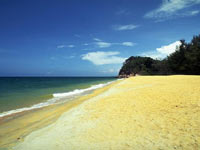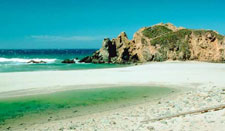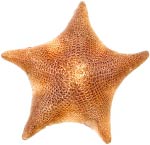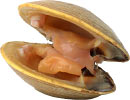| Sandy Shores
 A
sandy beach is made up of minute grains of sand or crushed shells and rock.
Because it is grainy, wind and water reshape a beach every day. Sandy shores
are exciting places with life in and underneath the water. A
sandy beach is made up of minute grains of sand or crushed shells and rock.
Because it is grainy, wind and water reshape a beach every day. Sandy shores
are exciting places with life in and underneath the water.
The Intertidal
Zone
 The
intertidal zone is the area exposed between high and low tides. In the
intertidal zone, part of the day is spent in open air and the rest of the
day is spent covered in ocean water. High tide brings
with it nutrients and food. When it goes out, the tide takes with it waste
products and disperses eggs and larvae. Because of the shifting sands,
organisms living in the intertidal zone on a beach have adapted to these
changing conditions. Without the cover of water, many animals simply shut
down during low tide. Some of the animals spend most of their life buried
under the sand. Others burrow into the sand when the tide is low or when
the crashing waves hit the shore. Some of the animals feed on materials
that washes ashore. Others filter food from the water. Still others feed
on tiny algae and bacteria among the sand grains. The
intertidal zone is the area exposed between high and low tides. In the
intertidal zone, part of the day is spent in open air and the rest of the
day is spent covered in ocean water. High tide brings
with it nutrients and food. When it goes out, the tide takes with it waste
products and disperses eggs and larvae. Because of the shifting sands,
organisms living in the intertidal zone on a beach have adapted to these
changing conditions. Without the cover of water, many animals simply shut
down during low tide. Some of the animals spend most of their life buried
under the sand. Others burrow into the sand when the tide is low or when
the crashing waves hit the shore. Some of the animals feed on materials
that washes ashore. Others filter food from the water. Still others feed
on tiny algae and bacteria among the sand grains.
Walking Along a Sandy Shore
Examine the strand line as you walk along a beach. You
can run into many interesting things.
Always wear shoes when you walk along the beach. Besides
the many natural items you find as you walk, unfortunately you'll encounter
the man made dangers of broken glass, litter, and pollution, too.
 Look
for sea stars. Sea stars are a very basic and primitive form of life. If
a sea star loses a leg, it will grow back. Obviously, such is not the case
with a human being or a mammal. Through thousands of years, mammals have
evolved to much more complex systems than starfish. Mammals' limbs are
more complex, and have a central nervous system. Look
for sea stars. Sea stars are a very basic and primitive form of life. If
a sea star loses a leg, it will grow back. Obviously, such is not the case
with a human being or a mammal. Through thousands of years, mammals have
evolved to much more complex systems than starfish. Mammals' limbs are
more complex, and have a central nervous system.
 You'll
find many sea shells. They are the former homes of snails and other aquatic
creatures. Their exoskelton (which means skeleton outside the body) is
all that remains of them. Shells are beautiful and fun to collect. You'll
find many sea shells. They are the former homes of snails and other aquatic
creatures. Their exoskelton (which means skeleton outside the body) is
all that remains of them. Shells are beautiful and fun to collect.
 Clam shells are exoskeltons of living creatures. In parts of the world,
such as the eastern coast of the United States, you can dig for clams along
the beach and then cook them.
Clam shells are exoskeltons of living creatures. In parts of the world,
such as the eastern coast of the United States, you can dig for clams along
the beach and then cook them.
| Disclaimer |
Copyright © 2002 Missouri
Botanical Garden
|
 |
|
